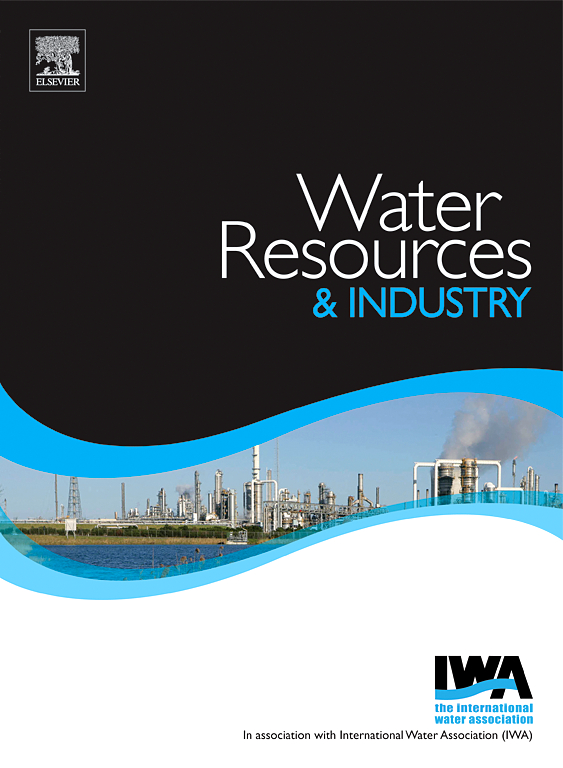Effective boron recovery from real acidic stripping solution by chemical oxo-precipitation method
IF 4.5
3区 工程技术
Q1 WATER RESOURCES
引用次数: 0
Abstract
The effluent generated during the desorption of boron from an ion exchange column is a major economic and environmental challenge of the ion exchange boron removal method. The chemical oxo-precipitation method (COP) is a rapid and efficient approach for boron removal from solutions of high concentration at room temperature. Therefore, this method was tested for boron removal using a real stripping solution obtained from boron desorption with hydrochloric acid after ion-exchange flue gas desulfurization (FGD) wastewater treatment. The following parameters were studied: hydrogen peroxide and calcium ratio to boron, pH of the solution, order of unit actions, pretreatment with oxidant, and calcium compound influence. We found that the literature recommended pre-oxidation step was unnecessary, and our process was rapid and effective, providing 96.8 % of boron recovery after 5 min at room temperature using the following conditions: H2O2/B = 3:1, Ca/B = 2:1, pH = 10.5 set after addition of chemicals. Since boron removal depends on at least three parameters, our novel approach to obtain optimal conditions of boron removal involved the precipitation of perborates from real wastewater by applying the central composite design (CCD) as an experimental strategy. The optimum conditions determined from the CCD experiment were pH = 9, H2O2/B = 3.5, and Ca/B = 3.5, resulting in 94 % boron recovery (in real experiment). Our study proved that the COP method was suitable for boron recovery from real acidic stripping solution, making the ion-exchange method of boron removal fully complete, economical, and environmentally friendly.

化学氧化沉淀法从酸性汽提液中有效回收硼
离子交换柱解吸硼过程中产生的废水是离子交换除硼法在经济和环境方面面临的主要挑战。化学氧化沉淀法(COP)是一种在室温下快速、有效地去除高浓度硼的方法。因此,采用离子交换烟气脱硫(FGD)废水处理后用盐酸解吸硼得到的真实溶出液,对该方法进行了脱硼试验。考察了过氧化氢、钙与硼的比、溶液pH、单元作用顺序、氧化剂预处理、钙化合物的影响。结果表明,在H2O2/B = 3:1, Ca/B = 2:1, pH = 10.5 set的条件下,在室温下5 min,硼的回收率可达96.8%,无需采用文献推荐的预氧化步骤。由于硼的去除取决于至少三个参数,我们的新方法是通过应用中心复合设计(CCD)作为实验策略,从实际废水中沉淀过硼酸盐,从而获得最佳的硼去除条件。CCD实验确定的最佳工艺条件为pH = 9, H2O2/B = 3.5, Ca/B = 3.5,硼回收率为94%(实际实验)。本研究证明COP法适用于实际酸性汽提液中硼的回收,使离子交换法除硼完全、经济、环保。
本文章由计算机程序翻译,如有差异,请以英文原文为准。
求助全文
约1分钟内获得全文
求助全文
来源期刊

Water Resources and Industry
Social Sciences-Geography, Planning and Development
CiteScore
8.10
自引率
5.90%
发文量
23
审稿时长
75 days
期刊介绍:
Water Resources and Industry moves research to innovation by focusing on the role industry plays in the exploitation, management and treatment of water resources. Different industries use radically different water resources in their production processes, while they produce, treat and dispose a wide variety of wastewater qualities. Depending on the geographical location of the facilities, the impact on the local resources will vary, pre-empting the applicability of one single approach. The aims and scope of the journal include: -Industrial water footprint assessment - an evaluation of tools and methodologies -What constitutes good corporate governance and policy and how to evaluate water-related risk -What constitutes good stakeholder collaboration and engagement -New technologies enabling companies to better manage water resources -Integration of water and energy and of water treatment and production processes in industry
 求助内容:
求助内容: 应助结果提醒方式:
应助结果提醒方式:


